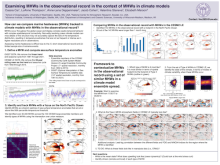Local trends in Sea Surface Temperature Anomalies and Marine Heatwaves in CESM-2 Large Ensemble
Cassia
Cai
School of Oceanography, University of Washington
Poster
We assess the dependence of spatio-temporal characteristics of Marine Heatwaves (MHWs) on the definition of the local long-term trend in local climate in a large ensemble of historical climate model simulations. We examine ensemble members of the CESM2 (Community Earth System Model Version 2) Large Ensemble Community Project (with 1° spatial resolution in the ocean) and the OISST (Optimal Interpolation of Sea Surface Temperature) satellite data (with 1/4° spatial resolution). MHWs occur throughout the global ocean and display complex spatio temporal behavior with complex spatio-temporal connectivity. Non-eddy resolving ocean climate models can miss the details of this structure and may not accurately capture the tails of the temperature distribution, resulting in temperature extremes that are not as frequent or intense as in higher resolutions models and in observations. We identify and track MHWs in both the CESM2 LE and OISST using Ocetrac. Ocetrac is a software packages, which identifies geospatial features from gridded SST datasets and tracks them in space and time while allowing for regions of anomalously high SST to merge and divide. We characterize the spatio-temporal evolution of MHWs using measures such as frequency, duration, intensity, rate of onset, growth, and decline, persistence, as well as measures that encode spatial and temporal information more explicitly, such as deformation and displacement.
The distribution of SST is red and as such the results of Ocetrac depend strongly on the definition of the trend and low frequency changes in SST. Here, we define the trend via a polynomial fit separately for each ensemble member, and then apply Ocetrac to the resulting anomaly field. This allows us to compare MHWs defined from the satellite SST record with those from CESM2 LE, matching each model MHW with its closest observed MHW by measuring the spatial and temporal scales of similarity. We examine the recurrence of certain types of MHWs in the different ocean basins and the dependence on the long-term trends of SST.
The distribution of SST is red and as such the results of Ocetrac depend strongly on the definition of the trend and low frequency changes in SST. Here, we define the trend via a polynomial fit separately for each ensemble member, and then apply Ocetrac to the resulting anomaly field. This allows us to compare MHWs defined from the satellite SST record with those from CESM2 LE, matching each model MHW with its closest observed MHW by measuring the spatial and temporal scales of similarity. We examine the recurrence of certain types of MHWs in the different ocean basins and the dependence on the long-term trends of SST.

Poster file
cai-cassia-confronting-poster.pdf
(4.5 MB)
